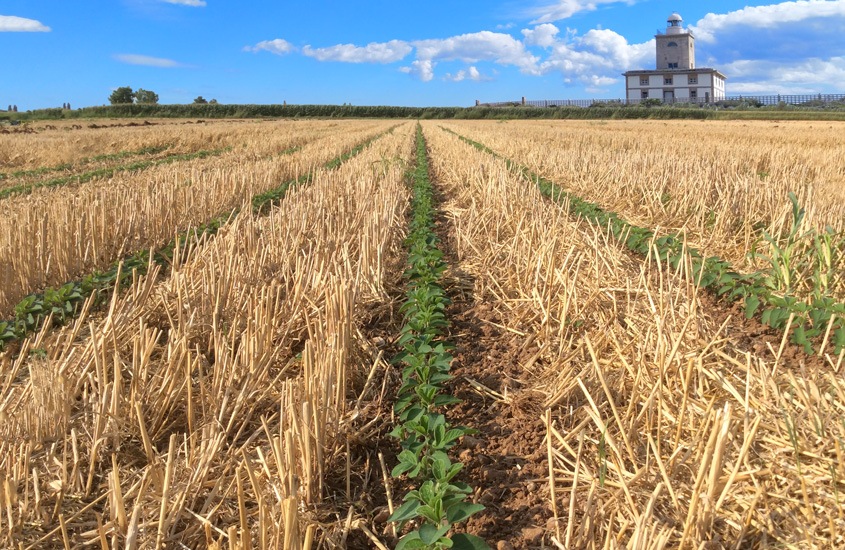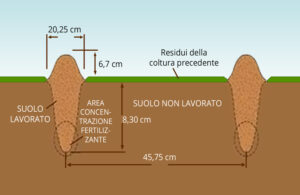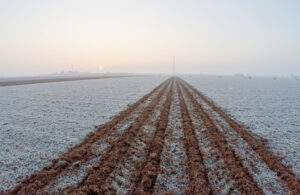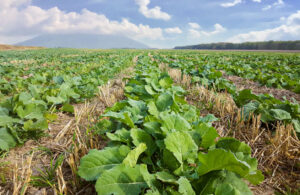AGRONOMIC SHEETS
STRIP TILLAGE
STRIP TILLAGE
The term STRIP-TILL (or STIP-TILLAGE) means a striping of the soil.
Strip Till is a smart, more economical and ecological working approach.
This is because it works only specific portions of land, keeping the inter-row surface unaltered.
Read on and find out why this approach is truly revolutionizing agriculture.

Strip Processing with Strip Hawk Easy
We know it well! The natural resources of our fields are limited.
The Strip Tillage method is suitable for those who want to further optimize the yield of their land, and at the same time minimize the degradation of the precious natural resources of the soil.
A whole new process, able to increase your production power, reducing costs and working time.
WHAT IS STRIP TILLAGE?
THE STRIP TILLAGE REVOLUTION
Strip-till (or strip tillage) is an incredible work process.
In fact, it allows you to exploit all agricultural land more efficiently, using only the natural resources strictly necessary for a specific crop cycle.
HOW IS IT POSSIBLE?
It is possible because strip tillage is a precision agriculture that works only well-defined strips of land. While the inter-row spaces remain almost unchanged.
A key tool that, in addition to considerably reducing working times, protects the balance and nutrient richness of the soil.
The necessary tool is called Strip Tiller, HERE you can find some examples.

Strip Tillage Soil Processing Scheme
WHAT ADVANTAGES FOR THOSE STARTING WITH STRIP TILL?
WHO CAN STRIP TILL USE FOR?
Strip Tillage is a working method suitable for any farmer who wishes to make the yield of his land more efficient.
Those who choose Strip-Till are well aware of the new standards of modern agriculture (conservative, precision, smart and with low environmental impact).
Do you still think that one machine can’t make that much difference?
This is how a quality Strip Tiller (Strip Tillage machine) has represented the turning point for many agricultural businesses.
ALL FOR ONE, ONE FOR ALL
Year after year, crop after crop.
Agriculture, it must be said, is objectively becoming more difficult.
Climate change, soil degradation, higher production costs, ever new regulations.
Final results? Agricultural processing becomes more expensive, both in terms of time and economic investments.
Seedbed preparation. Fertilization. Sowing.
If only there was a way to eliminate this complexity…
Think if I could do it all… in a single pass and with a single tool!
It sounds like a fairy tale, but it’s all true!
Agriculture evolves and these innovative machines aim not only to increase the yield of crops , but also focus on the well – being of those who cultivate and work the land day after day.
And the gain is real and easily quantifiable!
The equation is simple
Strip Till = Save Time + Save Money
More time to invest in monitoring your crops, more time to better manage the costs of your agricultural business, or simply more time for you.
Don’t forget about reducing your healthcare costs.
No more headaches with every new diesel bill!
AND THE RESULT ON THE FIELD?
In one go, the ideal situation is created so that each seed can germinate in the best conditions of humidity, porosity and temperature.
But that’s not all!
Oh no, because with this approach the advantages are many.
ADDITIONAL STRIP-TILLAGE BENEFITS:
ECONOMIC ADVANTAGES:
1. Reduction of working times (-30 / 40% compared to traditional processing).
2. Reduction in fuel consumption (-60 / 70% compared to traditional operation *). This aspect also directly affects the reduction of the Carbon Footprint, which is widely discussed in recent regulations.
3. Simplification of the machine park which involves:
4. Reduction of maintenance
5. Less economic investments
6. Greater effectiveness of fertilizers / wastewater being positioned in the strip with the possibility of reducing the dose of fertilizer up to -30 / 40% of PK
7. Speed of execution, reducing everything to a single pass on the ground at 7-12 km / h.
* traditional processing: plowing + grubbing + harrowing.
AGRONOMIC ADVANTAGES:
1. Improvement of the soil structure (leaving 70% of the surface undisturbed).
2. Reducing the number of passes also results in less soil compaction.
3. Increase of SO over time (organic substance).
4. Reduction of surface evaporation of water. Thanks to the improved structure + the SO there is a greater amount of water retained in the soil for the benefit of the crop.
5. Greater infiltration of water during rains.
6. Reduction of surface erosion (2/3 of the total land surface remain unchanged). There is talk of water and wind erosion, due to the constant presence of residues in the inter-row or to the cover crops sown in the inter-row.
7. More effective fertilization, thanks to the calculated positioning of the fertilizer, administered with absolute precision in correspondence with the strip worked with the Strip Tiller .
8. Reduction of trampling and soil degradation (due to the reduction of passages on the ground).
WHEN AND WHERE IS IT USED?
You need to know the type and characteristics of your land well and consider the climate you have in a given season.
Briefly, they can be divided into two categories: Tenacious and Light.
STRIP-TILL on TOUGH GROUND
By tenacious soil we mean a soil rich in silt and clay.
To use Strip Tillage processing on these types of terrain, it is necessary to intervene before the arrival of winter.
Why before winter?
In this way the entry into the field with the machinery (Strip Tiller) is favored before the operation becomes impracticable.
Another factor, perhaps more important.
In winter you can take advantage of the particular climatic conditions of the cold season (ice, rain, wind, low temperatures, etc.)
Using these atmospheric agents to your advantage allows you to have greater control over the soil, so as to make the clods burst and prepare the seedbed in the best possible way.
If necessary in the spring a second very light pass can be included (here it is important to set the machine with light working tools), to prepare the seedbed.

Strip Tillage in winter
STRIP-TILL on LIGHT GROUND
Soil is light when it contains a high percentage of sand.
On land of this type, it is possible to intervene through Strip Tillage directly in Spring.
In the case of loose soils (such as very sandy soils) it is possible to apply a Seeder to the Strip Tiller (or use multifunctional tools such as Strip Hawk Planter).
The maximum efficiency of the strip hawk is obtained in combination with a seeder (possibly hooking it up with the special trolley).
By doing so, you can conveniently carry out Soil Preparation and Sowing at the same time. Using the right Strip Tiller you can make your agriculture more efficient by combining the different agricultural processes!
THE SPECIAL CASE OF SECOND HARVESTS – COLZA
The Strip Till technique is widely used even after the typical winter crops (wheat, barley, rye, etc.), for the sowing of soy, corn and sorghum in second harvest.

Second Harvest with Strip Till
For high-level results, it is best to proceed with machinery such as Strip Hawk Planter. With the rapid processing of Strip Planter (which does Strip Till and Sow at the same time) the loss of moisture in the soil is drastically reduced, to the advantage of the uniformity of germination of the chosen crop.

Strip Tillage with Rapeseed
Do you already have a seeder at home?
No problem! The Strip Tiller can adopt a special trolley to hook your seeder.
One of the crops for which we recommend the Strip-Till cultivation is certainly Rapeseed, as, given the sowing time (late summer), the conditions are very similar to a second crop.
For rapeseed, we know it is essential to center the sowing window.
A Strip Tiller + Seeder is the right vehicle for this mission, managing to do everything in a much shorter time frame.
But how do you go in practice from traditional agricultural processing to more efficient agriculture with Strip-Tillage?
HOW DO I GET STARTED WITH STRIP TILL?
Here are some recommendations:
• Choose the Strip Tiller machine that best suits the power of your tractor and the surface of the land to be worked.
• Schedule the execution of individual interventions.
• Sow the seed correctly (well in the center of the worked strip). You can help yourself by using automatic guidance systems with RTK signal.
• Makes all elements work evenly.
• Use a travel speed appropriate to the situation (7-12 km / h).
• Finally, remember: the first machine that must enter the field is the brain!
To work in agriculture there are a thousand variables to consider (agronomy, soil, climate).
If you have any doubts or are not sure what to do, ask Marco, our trusted agronomist, for advice.
WHAT DO YOU NEED?
And that your company balance sheet can really improve… thanks to a single swipe!
What to do now?
Well, all you have to do is include a Strip Tiller that is up to your business in your fleet!
WHICH STRIP TILLER TO CHOOSE?
We obviously recommend STRIP HAWK EASY.
Even better in its version with seeder.
Here at MOM Officine, we have designed the Range Strip Hawk with the ambition to create unique machines of their kind, able to fit easily and effectively within an already well-structured agricultural system. And (the satisfaction of our customers confirms this) we really believe we have succeeded!
The adaptability of each element of Strip Hawk Easy is able to satisfy the most particular needs.
But let’s analyze them specifically.
ELEMENTS THAT MAKE UP STRIP HAWK
• CUTTING DISCS:
They favor the cutting of crop residues thanks to the particular wavy profile.
• STAR DISCS:
Move the crop residue from the processing strip.
• CONTAINMENT DISCS:
They work the strip on the surface, delimiting its width to 15-20 cm.
• KNIFE TOOL:
Works the soil to a depth of 15-30 cm. It can be set up for simultaneous burying of fertilizer (solid-liquid) or zootechnical waste.
• ROLLERS:
They refine and settle the ground after the intervention of the anchor (or Knife Tool), eliminating any clods.
